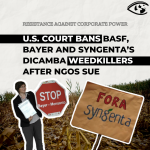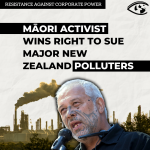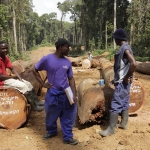A First Class Poison
The Health Impacts of Methyl Bromide
Methyl Bromide and Human Health
Methyl bromide affects human health both directly and indirectly. It is a complete biocide that kills most living organisms in soil, agricultural products and in buildings where it is applied. The U.S. Environmental Protection Agency classifies methyl bromide as a Category I acute toxin -- EPA's most deadly category of substances. It is hazardous to people who work with it and those who live near where it is used. As a potent ozone depleter, methyl bromide indirectly increases the health problems caused by exposure to ultraviolet-B radiation, including skin cancer, eye cataracts and suppressed immune systems.
Health Effects of Direct Exposure
Methyl bromide is toxic primarily to the central nervous system and damages lungs, kidneys, eyes and skin. Many symptoms of exposure resemble those of alcohol or drug intoxication: blurred vision, weakness, dizziness, headaches, behavior symptoms resembling psychosis, and lethargy. Death by methyl bromide poisoning is medically described as "intoxication." Recovery from the more severe symptoms of methyl bromide toxicity, such as pneumonia, severe weakness, paralysis, and heart problems, can take days to several months, if it happens at all.
Fetuses may also be harmed by methyl bromide. Toxicology studies indicate that when pregnant animals are exposed to this pesticide, their unborn fetuses can suffer birth defects.(1) Because of the pesticide's ability to cause birth defects in laboratory animals, in 1992 the California Department of Pesticide Regulation restricted the use of methyl bromide in structural fumigation.(2)
Studies show that harmful concentrations of methyl bromide can drift several miles from the site of fumigation, posing a threat to nearby residents and workers who may be exposed to damaging levels through direct inhalation of the gas.(3) Unlike other commonly used pesticides, however, methyl bromide is believed to leave little or no residues in most foods.
Worker Health and Safety
Workers involved in the manufacture and use of methyl bromide run the greatest risk of toxic exposure and resulting injury. The chemical is heavily used in California, where state agencies recorded 148 systemic illnesses, 52 eye injuries, and 60 cases of skin damage caused by methyl bromide between
1982 and 1990.(4) State officials acknowledge that reported pesticide injuries represent just a portion of actual cases. From 1984 to 1990, methyl bromide ranked eighth in order of acute illnesses caused by pesticides in California, even though state law restricts its use to licensed professionals who are trained in safe application techniques.(5)
Farmworkers who follow fumigation tractors to help spread tarps over treated soil are exposed to dangerously high levels of methyl bromide. As a result, California has drastically reduced the number of hours any individual can work in methyl bromide field fumigations.(6) Anecdotal reports from California strawberry and Florida tomato workers describe permanently dimmed eyesight and loss of feeling in fingers, which farmworkers blame on work in methyl bromide fumigated fields. For years, the United Farm Workers has
demanded a ban on the use of methyl bromide since the chemical has been cited as the cause of more occupationally related deaths than any other pesticide in California.(7)
Among processed food workers there is also little protection from the damage methyl bromide can inflict. In 1986, seven union workers in the Diamond Walnut processing plant in Stockton, California, were sent to the hospital as a result of methyl bromide fumigation. Other workers complained of severe headaches and cracked and bleeding lips following fumigation.
Off-site movement of methyl bromide also threatens those near fumigation areas. Neighbors are rarely notified that a toxic gas is being used. In 1992, an off-site drift of methyl bromide from a strawberry field in Oxnard, California, made six people ill.(8) Methyl bromide fumes entered the area after the plastic tarps intended to contain the chemical were removed. In 1987, 140 people were evacuated from a California labor camp and 71 fell ill after children tore holes in a tarp covering a fumigated field.(9)
Ironically, it is precisely the properties that make it valuable as a pesticide that make methyl bromide such a problem for those who work with or live near it. Methyl bromide is readily absorbed into wood, grain and other materials and is released slowly. Slow release of methyl bromide killed two people in Redwood City, California, in 1992, after they reentered their home following fumigation for pest extermination.(10) Fifteen deaths occurred as a result of residential methyl bromide fumigation in California between 1982 and 1990.(11)
Ozone Depletion and Health
Methyl bromide also harms human health indirectly by its significant contribution to ozone loss. The stratospheric ozone shield prevents ultraviolet-B (UV-B) radiation from reaching the Earth's surface (see "Methyl Bromide Destroys the Ozone Layer" factsheet). Depletion of the ozone layer leads to increased UV-B radiation exposure and related health problems, including skin cancer, eye cataracts and suppression of the immune system. It is estimated that for every 1% drop in the ozone layer, the Earth's surface is exposed to a 1-2% increase in harmful UV-B radiation.(12)
Skin Cancer
In 1995, the Centers for Disease Control (CDC) reported that skin cancer is the most rapidly increasing cancer in the United States. CDC concluded that death rates from melanoma -- the most deadly form of skin cancer -- rose 34% from 1973-1992, making melanoma the fastest growing killer among cancers in men (particularly over age 50).(13) Over 31,000 Americans died from melanoma between 1988-1992, including
2,210 people in Florida and 3,700 people in California. The CDC estimates that 7,200 people will die nationwide from malignant melanoma in 1995.(14) Another study, conducted by Boston University researchers, found that the rate of melanoma increased more than 300% between 1950 and 1989.(15)
As ozone depletion continues, these numbers are expected to rise. Scientists predict a sustained 1% decrease in stratospheric ozone will lead to a 2% increase in the incidence of non-melanoma skin cancer.(16) To dramatize the relationship between increased skin cancer risk and UV-B exposure, the National Weather Service recently began including ultraviolet radiation levels in selected daily weather reports. Other countries, including Canada, are issuing similar daily UV reports.
Cataracts and Immunosuppression
Since the cornea and the conjunctiva (the outer surface and lining) of the eye are approximately 6 times more sensitive to UV-B radiation than skin, ozone loss can also have chronic effects on human and animal eyes, including cataracts. Currently more than 20% of all cataracts are caused by exposure to UV radiation.(17) Scientists estimate that for every 1% decrease in the ozone layer, 100,000-150,000
additional cases of cataract-induced blindness will occur worldwide.(18)
Probably the most serious consequence of excessive UV-B exposure is direct suppression of the human immune system, which reduces the ability to combat infection. Immunosuppression can in turn increase the number and severity of bacterial and viral diseases-- such as chicken pox, measles, and herpes -- as well as cancer and other health problems. Excessive UV-B exposure may also activate the HIV virus, hastening the onset of full-blown AIDS.(18)
For More Information:
- Centers for Disease Control, Morbidity and Mortality Weekly Report, May 5, 1995.
- U.S. Environmental Protection Agency, "Pesticide Factsheet: Methyl Bromide," Office of Pesticides and Toxic Substances, August 1986.
- U.S. Department of Health and Human Services, "Draft Toxicological Profile for Bromomethane," February 1991.
- World Health Organization, "International Program on Chemical Safety and Environmental Health Criteria for Methyl Bromide," 1991.
- Zurer, Pamela, "Enhanced UV Radiation Linked to Skin Cancer, Plant Damage," Chemical and Engineering News, May 24, 1993.
References
- California Department of Pesticide Regulation, Methyl Bromide (a document prepared for the Developmental and Reproductive Toxicant Identification Committee for the consideration of methyl bromide as a developmental toxicant under Proposition 65), March 7, 1994.
- California Department of Pesticide Regulation, "Toxicological Review Prompts Changes in Structural
Fumigation," Press Release, April 2, 1993. - California Department of Pesticide Regulation, "Information Sheet Discussing Size of Warning Zone:
Proposition 65 Safe Use Determination for Methyl Bromide," November 30, 1993. - Brodberg, Robert et al., Estimation of Exposure of Persons in California to Pesticide Products Containing Methyl Bromide, California Department of Pesticide Regulation, June 1992.
- Pease, Bill et al., Preventing Pesticide Related Illness, California Policy Seminar, 1993.
- California Environmental Protection Agency, Office of Environmental Health Hazard Assessment, "Questions and Answers on Methyl Bromide," December 1993.
- Moses, Marion, National Farmworker Health Group Report, Pesticide Education Center, 1986.
- "Toxic Fumes From Field Overcome Six in Oxnard," Press Courier, September 6, 1992.
- Brodberg et. al, 1992.
- "Methyl Bromide Pegged as Ozone Layer Destroyer," San Francisco Examiner, April 17, 1992.
- Brodberg et al., 1992.
- United Nations Environment Programme, The Impact of Ozone Layer Depletion, 1992.
- Centers for Disease Control, Morbidity and Mortality Weekly Report, May 5, 1995.
- Ibid.
- Miller, D. and Weinstock, M.,"Non-Melanoma Skin Cancer in the U.S.: Incidents, "Journal of the American Academy of Dermatology, vol. 30, no.5, May 1994.
- United Nations Environment Programme, The Science, Environmental Effects and Technology and Economic Assessments Synthesis Report, December 1994.
- Written statement by David Doniger, Counsel to Assistant Administrator, U.S. Environmental Protection Agency, for June 28, 1994 press conference launching UV Index.
- United Nations Environment Programme, Montreal Protocol Assessment Supplement, 1992.
- United Nations Environment Programme, Synthesis Report of Ozone Scientific Assessment Panel, November 1991.
Reproduced with permission
Methyl Bromide Briefing Kit (1995)
Methyl Bromide Alternatives Network
c/o PANNA
49 Powell St., Suite 500
San Francisco, CA 94102
USA
Tel: (415) 981-1771
Fax: (415) 981-1991
Email: panna@panna.org
- 181 Food and Agriculture



